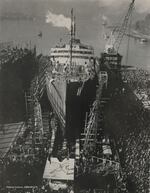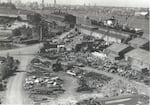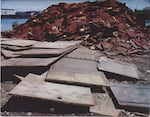Paul Fishman spots a rusty chunk of metal jutting out of the riverbank on Portland’s South Waterfront.
“Ah-ha!" he said. “Here’s a piece of [a] ship’s hull."
The piece came from a World War II ship – one of the few signs of the post-war industry that used to be here.

President Roosevelt called for a seven-day work week to build ships even faster to win the war.
City of Portland Archives
During World War II, the site was one of several Willamette River shipyards devoted to building military vessels. But when victory made all those warships obsolete, this stretch of the waterfront became the scrapyard where many of those ships were torn apart.
It wasn’t too long ago that the site was covered in ship scraps laced with toxic pollutants like lead, asbestos and the industrial chemical polychlorinated biphenyl, or PCB.
Without World War II's shipyards, there would likely have been no shipbreaking boon in Portland. During the war, Portland’s waterfront bustled with the launching of new warships – one every four days at the peak of the war effort.
WATCH: Battle Ready - The Digital Documentary
President Franklin D. Roosevelt told Americans cargo ships would help bring liberty to Europe. He called for a seven-day work week to build these liberty ships even faster.
“While we are proud of what we are doing, this is certainly no time to be content,” Roosevelt said at one of the many ship launchings. “We must build more cargo ships, and still more cargo ships. And we must speed the program until we achieve a launching each day. Then, two ships a day.”
Portland heeded the president’s call, according to Ed Wilson, a librarian at the Oregon Maritime Museum.
“As soon as one ship was launched, the keel was immediately laid for the next ship,” he said. “Speed was encouraged, and many times quality suffered. But these ships were designed to be essentially expendable. If the United States got two trips across to support the troops, it was a job well done.”
Selling ship scraps was a natural extension of the resale business Sam Zidell had started after emigrating to the U.S. from Russia, Richards said.
“Wherever he saw an opportunity to make a profit, he’d buy it and turn around and sell it to somebody else,” Richards said.
"And really the ship dismantling business was the same sort of business."
To operate the business, Zidell leased a portion of the old Commercial Iron Works shipyard, which already had a dock where workers had built ships for World War II.
Emery Zidell's son Jay grew up helping his dad build what once was the nation’s largest shipbreaking operation.

The Zidell ship-breaking business grew as more and more warships became obsolete.
Courtesy of Zidell Companies
ldquo;It was a good business for us to be in,” he said. “We were one of maybe four, five ship dismantlers in the entire country. We had destroyer escorts. We had destroyers. We had submarines. The ship we had the most of was called the liberty ship. It was just a cargo ship used during World War II.”
As the years went on and the federal government gave up on more and more of its mothballed World War II ships, the business grew and the company expanded its lease and eventually purchased the site, according to Richards.
Thanks to Zidell, hundreds of warships would come to rest right back where many of them started – their toxic contents scattered along the riverbank.
‘Mounds Of Metal’
Emery’s daughter Charlene Zidell, now the director of corporate communications for Zidell Companies, remembers what her family’s scrapyard used to look like.

The Zidell scrapyard was covered in mounds of rusty metal, much of which came from dismantled World War II ships.
Courtesy of Zidell Companies
ldquo;Mounds and mounds and mounds of metal – just one heap after the next,” she said. “It was very rusty and gritty, and you’d kind of go ‘Who would want to go out there?’”
As a little girl, she got to tour some of the ships before they were dismantled. And she helped out when the family held military surplus sales – essentially giant garage sales for all the items, including bedding and kitchen supplies, that came off the ships in the dismantling process.
“People would be lined up for blocks to come and buy this stuff,” she said. “It was just like treasures for people.”
But the shipbreaking process was messy, and it left a lot behind on the land and in the river. The insulation on the ships, the wiring, the linoleum on the floors and even the paint was full of contaminants.
Scrapyard workers would
burn the toxic insulation off copper wires in open pits
alongside the Willamette River. They frequently spilled oil while pumping it out of the ships; then they’d
before they cut the ships apart. And they spread pollution all over the site as they hauled away pieces of the ships. Some of it – like asbestos and PCBs causes cancer.
Stepping Up
The company stopped dismantling ships in the late 1970s.
Only later would the family confront the big environmental price tag that came with this lucrative post-war industry.
“The world’s changed a lot since my dad was young and active and growing the business," Jay Zidell said. "As time went on, and civilization’s information base became better, we all came to realize that some of the activities we were engaged in had created environmental issues on the site.”
In 1986, environmental
regulators flagged the property
as potentially hazardous. After an investigation, the Oregon Department of Environmental Quality invited the company to join a voluntary cleanup program, and according to Jay Zidell, in 1994, the company agreed.
"Once we became aware of it, we knew we had a legal responsibility, and we wanted to step up and do the right thing," he said. "It was a vastly larger undertaking, both in time and cost, than we had any idea going into it."
The pollution covered 30 acres of land and half a mile of riverbank. The Zidells soon found out that reviving this site was no easy task.
20 Years And $20 Million Later ...
Just testing the site and developing a cleanup plan took years. Once they were ready to start the actual cleanup, the family hired Fishman as their environmental consultant to oversee the project.
Fishman knew it was a little crazy to take the job of overseeing an environmental cleanup of the site. But eventually, he agreed to what would turn out to be the biggest project of his career.

Paul Fishman points out one of the rusty World War II ship scraps still left on the bank of Portland’s Willamette River.
Chris Nolan
ldquo;It took three breakfast meetings before I said yes,” Fishman said. “‘I said, ‘I’m only going to work half-time because I’m going to need the rest of the time to see a therapist to figure out why I’m saying yes.’”
Just reaching the contaminated soil and riverbottom to do the environmental cleanup would be a challenge.
“This riverbank before we started was very steep, covered in all kinds of rubble – concrete, asphalt, metal, all kinds of industrial metal and urban debris that had been dumped here," Fishman said. "It was truly a mess.”
Testing showed hot spots of contamination all along the dock site where workers had cut the warships into pieces.
The ecological cleanup meant removing the most contaminated soil and river sediment. They covered the land and a portion of the riverbed with a thick layer of clean sand, dirt and gravel. Then they started planting – more than 15,000 native plants.
“This entire property now is capped," Fishman said. "We’ve cut off the source of contamination. So, if I want to walk on this beach, if I want to paddle my kayak, if I want to swim in the river, it’s all good. It’s all the way it should be.”All in all, the cleanup took more than 20 years and cost more than $20 million. Thanks to favorable court rulings, the Zidells recouped a large portion of their expenses from
and the
that supplied the ships.
And now, it’s time to cash in.
In September, the company announced it will be shuttering the barge-building business that Emery Zidell started by recycling World War II ship scraps. The closure will leave even more land open for redevelopment.
The Zidells have 30 acres of prime riverfront property and a vision for the post-industrial neighborhood they want to see there in the future.
